| |
|
|
21.
| Skyline |
| |

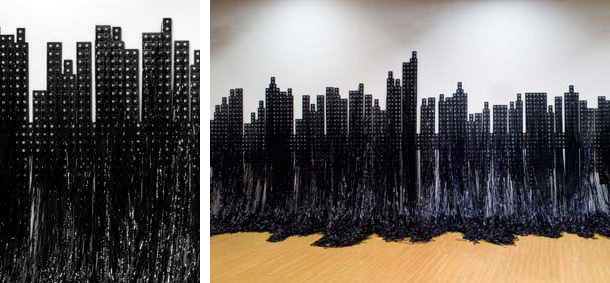
2007, VHS, tapes, 800 x 365 cm.
Exhibition view of Fuck Architects: chapter III, FRAC Alsace, 2009, Sélestat.
Courtesy of the artist and Ceysson & Bénétière, Paris.
Ed. of 5 + 1 A.P.
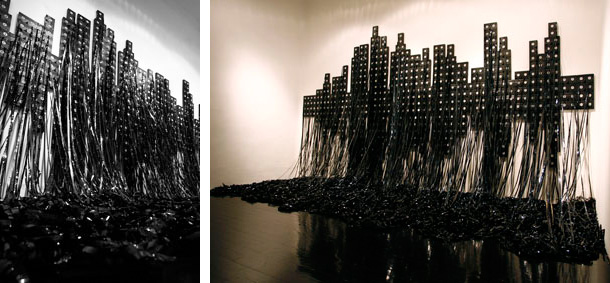
2007, VHS, tapes, 800 x 365 cm.
Exhibition view of The space between now and then, part 1, Galeria OMR, 2011, Mexico.
Courtesy of the artist and Ceysson & Bénétière, Paris.
Ed. of 5 + 1 A.P.
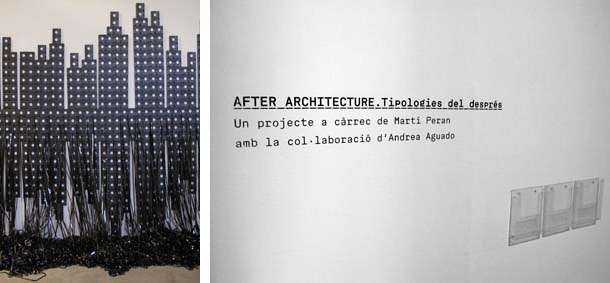
2007, VHS, tapes, 800 x 365 cm.
Exhibition view of After Architecture, Santa Monica Art center, 2009, Barcelona.
Courtesy of the artist and Ceysson & Bénétière, Paris.
Ed. of 5 + 1 A.P.
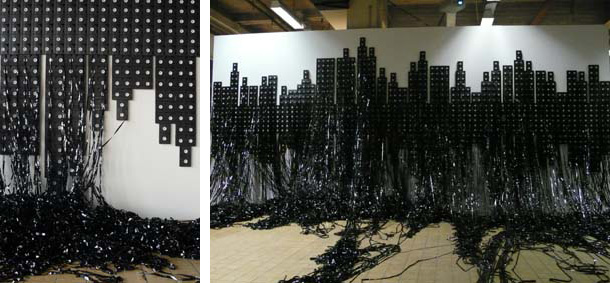
2007, VHS, tapes, 800 x 365 cm.
Exhibition view of Fuck Architects: chapter III, 1st Brussels Biennial, 2008, Brussels.
Courtesy of the artist and Lawrie Shabibi, Dubai.
Ed. of 5 + 1 A.P.
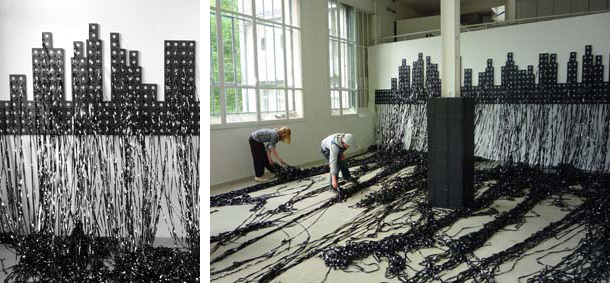
2007, VHS, tapes, 800 x 365 cm.
Exhibition view of Fuck Architects: chapter II, Le Creux de l'Enfer, 2008, Thiers.
Courtesy of the artist and Ceysson & Bénétière, Paris.
Ed. of 5 + 1 A.P.
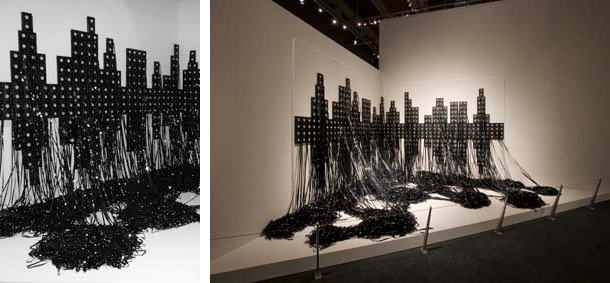
2007, VHS, tapes, 800 x 365 cm.
Exhibition view of Visionary tales of a balanced earth, Te Papa museum, 2008, Wellington.
Courtesy of the artist and Jane Lombard, New York.
Ed. of 5 + 1 A.P.
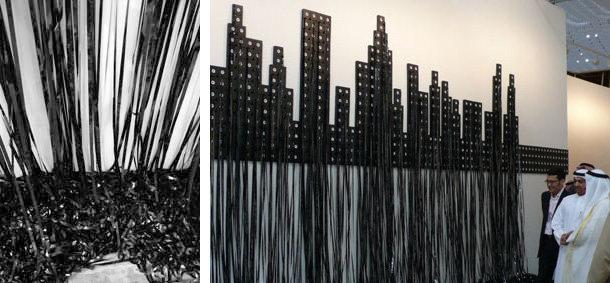
2007, VHS, tapes, 800 x 365 cm.
Exhibition view of 8th Sharjah Biennial, art, ecology and the politics of change, 2007, Dubaï.
Courtesy of the artist and Ceysson & Bénétière, Paris.
Ed. of 5 + 1 A.P.
 Video Video
'' The magnetic tape that was protected by the cassettes hangs all the way to the floor,
creating a heap that reminds the viewer of the rubble of New York and symbolizing an unraveling memory. ''
Thomas Flagel, Poly, 2009
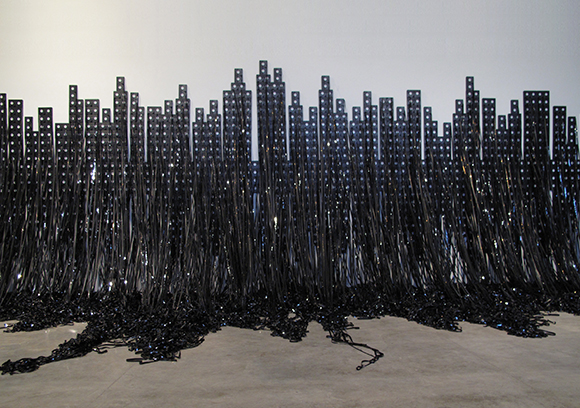
Skyline
Exhibition view of After Architecture, Santa Monica Art center, 2009, Barcelona.
Courtesy of the artist.
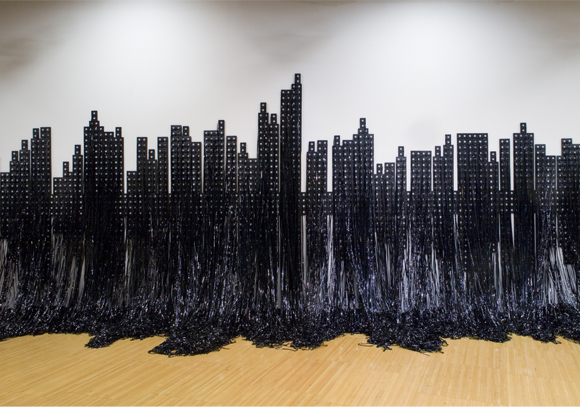
Skyline
Exhibition view of Fuck Architects: chapter III, FRAC Alsace, 2009, Sélestat.
Courtesy of the artist.
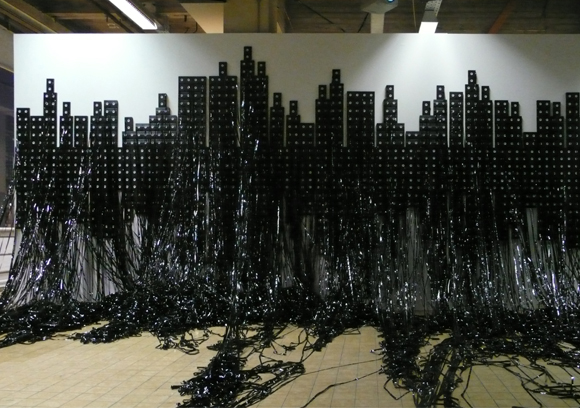
Skyline
Exhibition view of Fuck Architects: chapter III, 1st Brussels Biennial, 2008, Brussels.
Courtesy of the artist.
|
|
|
|
|
| This work was part of 8th Sharjah Biennial, 2007, UAE.
This work was part of Biennale de Bruxelles - Fuck architects: chapter III, Brussels, 2008.
|
Skyline est une proposition sculpturale-architecturale polymorphe, qui peut être présentée dans des configurations différentes selon les espaces.
Les cassettes vhs détournées en matériaux de construction ont un emploi plastique récurrent dans les travaux récents de mounir fatmi.
De la même manière que le boîtier de la cassette neutralise et protège un contenu qui nous reste invisible, Skyline suggère d’emblée la complexité de l’«habiter ». La construction architecturale rend possible l’existence d’un « intérieur », d’un chez-soi, qui sépare du regard des autres, qui permet le secret, l’intimité, la séparation des espaces privés-publics sans lequel nous sommes projetés en marge de la société, éminemment vulnérable. Elle est aussi comme un « vêtement » protecteur, dit l’artiste, rempart contre l’hostilité que constitue le monde extérieur, qu’il s’agisse des forces de la nature ou de l’autre, l’ « ennemi ». Pourtant, nous n’oublions pas face à un tel paysage, la fragilité de toute construction, de ce rempart qui peut-être aussi source de destruction. Dans la guerre traditionnelle comme dans le terrorisme, c’est souvent par la destruction du bâtiment qu’adviennent les pertes humaines. Le 9.11 est là pour nous le rappeler. Ou comment l’un des plus célèbres skyline du monde, symbole du triomphe économique et du pouvoir révéla sa fragilité.
La cassette vhs, c’est aussi l’instrument de la copie. De quel skyline du monde cette frise architecturale à l’esthétique minimaliste est-elle le reflet? New York, Shangaï, Dubaï ? Tous ceux qui se déplacent dans les plus grandes métropoles du monde sont frappés par cette uniformisation du paysage urbain, qui a la fois renforce le sentiment de « village planétaire », la certitude de la globalisation économique et de la modélisation capitaliste des modes de vie en même temps crée l’illusion que cette normalisation recouvre une uniformisation des richesses. Cette mimesis architecturale, pour reprendre le mot de Derrida, devient dès lors un essentiel enjeu politique.
Les bandes dévidées des cassettes forment sous la construction un magma d’un noir brillant.
Peut-être renvoient-elles à quelque chose comme de ténébreuses Euménides, qui appartiennent au monde du dessous et de la violence calculée –autre manière de symboliser la peur de la destruction et la fragilité du construit, la violence latente à l’énergie de la ville.
Elles sont aussi plus probablement manifestation de la fuite, de la perte, de la fragilisation des existences individuelles soumises à la pression et au flux permanent de la mégapole.
Skyline a été présenté pour la première fois à la 7ème biennale de Sharjah, art, ecology and the politics of change, à Dubaï, en 2007.
Marie Deparis
|
|
Skyline is a polymorphous scultural-architectural proposition, which can be arranged in different configurations depending on the space.
VHS cassettes, appropriated as construction material, are a recurrent feature of mounir fatmi's recent work.
At first Skyline hints at the complexity of “inhabiting”. In the same way that the content of a video remains invisible to us in its neutralising and protective shell, the architectural construction makes possible the existence of an “interior”, a home. It separates us from the gaze of others, allows secrets, intimacy and the separation of public and private, without which we would be thrown – eminently vulnerable - to the margins of society. It is also like protective “clothing” says the artist, a defence against the hostility of the outside world, be it the forces of nature or another “enemy”. Faced with such a cityscape, however, we cannot forget the fragility of constructions, ramparts that could also be a source of destruction. In war as in terrorism, human loss often results from the destruction of buildings. 9.11 reminds us of that. Or how one of the most famous skylines in the world, symbol of power and economic triumph, revealed its fragility.
The VHS cassette is also an instrument of copy. Which skyline of the world does this architectural frieze, with its minimalist aesthetic, represent? New York, Shanghai, Dubai? Those who travel to the world's largest cities are struck by the uniform nature of the urban landscape. This compounds
the perception of a “global village”, the certainty of economic globalisation and the capitalist model of a way of life, but also creates the illusion that this standardisation conceals a uniformity of riches. This architectural mimesis, to borrow the words of Derrida, becomes henceforth a political issue.
The unwound film from the cassettes form a magma of glistening black under the buildings. They may refer to something like the dark Eumenides, who belong to the underworld of calculated violence – another way of symbolising the fear of destruction and the fragility of structures – the latent violence of the city's energy.
They are also more likely to be a manifestation of the evasion, loss and weakening of individual beings subjected to the permanent pressure and flux of the city.
Skyline was presented for the first time at the 7th biennial of Sharjah, Ecology and the Politics of Change, in Dubai, in 2007.
Marie Deparis
Translation: Caroline Rossiter.
|
|
|
|